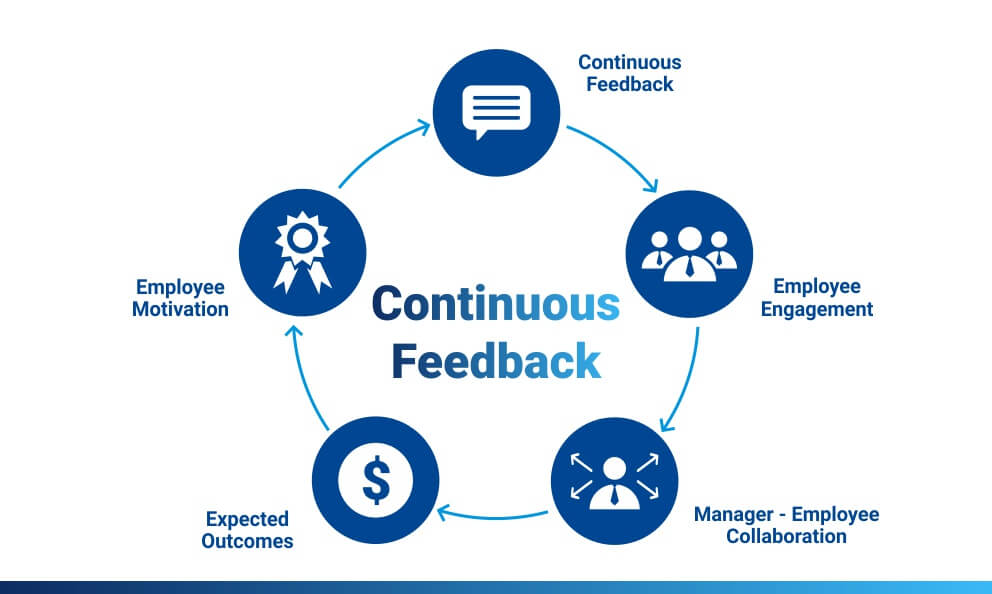Employee Experience Management
“Kritisieren, verurteilen oder beschweren Sie nicht nur, sondern geben Sie stattdessen ein konstruktives Feedback” – Dale Carnegie
Kontinuierliches Feedback
- 1 Kontinuierliches Feedback: Definition
- 2 Kontinuierliches Feedback und Leistungsmanagement
- 3 Maßnahmen zur Einführung eines kontinuierlichen Feedbacks im Leistungsmanagement
- 4 Vorteile von kontinuierlichem Feedback
- 5 Software für kontinuierliches Feedback – QuestionPro’s Feedback App
- 6 1:1 Live Online-Präsentation: Kontinuierliches Feedback schaffen mit der Employee Experience Management Plattform von QuestionPro
- 7 Software für kontinuierliches Feedback jetzt 10 Tage kostenlos testen!
Kontinuierliches Feedback: Definition
Kontinuierliches Feedback ist definiert als ein Mechanismus oder ein Prozess, bei dem Mitarbeiter eines Unternehmens kontinuierliches Feedback in einer systematischen Art und Weise erhalten. Die Schlüsselwörter sind hier “kontinuierlich” und “systematisch”. Die Herausforderung eines jeden Unternehmens ist es, kontinuierliches Feedback auch tatsächlich systematisch anzuwenden. Das ist insbesondere in großen Unternehmen mit verteilten Standorten und einer großen Anzahl von Mitarbeitern kein leichtes Unterfangen. Das Feedback muss kontinuierlich systematisch erfasst und ausgewertet werden, was sich rein organisatorisch als schwierig darstellen kann.

Kontinuierliches Feedback und Leistungsmanagement
Laut einer von Forbes durchgeführten Studie halten fast 75 % der Mitarbeiter kontinuierliches Feedback für wichtig, aber weniger als ein Drittel erhält es und oft wird als Grund fehlende Zeit aufgeführt. Dabei läßt sich der Prozess des kontinuierlichen Feedbacks im Grunde vollständig automatisieren, Mitarbeiter sind nicht mehr an Jahresgesprächen interessiert und fordern kontinuierliches Feedback ein. Deshalb mussten Unternehmen das gesamte System ändern, wie und wann Mitarbeiter ihr Feedback erhalten. In dieser technologiegetriebenen Welt müssen Unternehmen darauf achten, dass sie sich stärker auf Prozesse und Programme konzentrieren, die darauf ausgerichtet sind, Talente zu halten und ihnen die Möglichkeit zur Weiterentwicklung geben.
Betrachten wir diesen Mechanismus aus der Perspektive der Mitarbeiter. Stellen Sie sich vor, Sie tragen ein Fitnessgerät und Ihr Gerät gibt Ihnen Ihre Schrittzahl am Ende des Jahres und nicht täglich an. Sie hätten keinen Grund, Ihren Ernährungsplan oder Ihre Trainingsroutine zu ändern, und die Ergebnisse, die Sie zu erzielen bereit sind, werden ein weit entfernter Traum sein.
Es ist keine Überraschung, dass Mitarbeiter das Bedürfnis nach rechtzeitigem und kontinuierlichem Feedback und gebührender Anerkennung haben. Es ist ein Attribut, eine Voraussetzung dafür, dass sie bei der Arbeit bessere Leistungen erbringen. Sie sehen dies als eine Gelegenheit, ihre Karriere in die richtige Richtung zu lenken. Die Einführung eines Programms zum Leistungsmanagement mit kontinuierlichem Feedback ermöglicht es Unternehmen, den Mitarbeitern das zu geben, was sie wirklich wollen, so dass die Mitarbeiter aus dem laufenden Feedback einen größtmöglichen Nutzen ziehen und ihre Weiterentwicklung wiederum in das Unternehmen fließen lassen können.
Maßnahmen zur Einführung eines kontinuierlichen Feedbacks im Leistungsmanagement
1. Machen Sie kontinuierliches Feedback nicht zu einem beängstigenden Prozess: Das menschliches Gehirn ist überempfindlich gegenüber allem, was es für eine Bedrohung hält. In Organisationen, in denen Mitarbeiter Angst haben, ihre Fehler zuzugeben, führt dies nur zu einer Kultur des Zweifels. Keine Organisation würde eine Kultur fördern wollen, in der die Führung ihren Mitarbeitern nicht vertraut oder umgekehrt.
Um dies zu vermeiden, sollten Sie den Feedback-Prozess nicht zu einem beängstigenden Prozess machen. Kontinuierliches Feedback ist kein Mechanismus, um Mitarbeiter permanent auf Fehler hinzuweisen und “Geständnisse” entgegenzunehmen, warum sie ihre Ziele nicht erreichen konnten. Kontinuierliches Feedback ist ein Prozess, der sowohl den Mitarbeitern als auch der Organisation helfen soll, sich zu verbessern. Halten Sie diesem Prozess einfach und subtil, so, dass es zu etwas vollkommen Normalem wird, dann macht kontinuierliches Feedback auch wirklich einen Sinn!
2. Geben Sie öfter Feedback: Eine überwältigende Mehrheit aller Mitarbeiter wünscht kontinuierliches Feedback von ihren Vorgesetzten, aber nur eine Handvoll von ihnen erhält es auch tatsächlich. Für Manager ist es wichtig, dass sie effektives und zeitnahes Feedback zur Leistung der Mitarbeiter geben. Kontinuierliche und vor allem kurze Feedback-Zyklen können ein Unternehmen revitalisieren. Viele Organisationen sind dabei, ihre Jahresgespräche erfolgreich auf einen kontinuierlichen Feedback-Prozess umzustellen. Mit diesem Prozess können Manager die Mitarbeiter bei der Verbesserung ihrer Arbeit unterstützen und ihnen auch helfen, einen Weg für ihre langfristigen Ziele zu ebnen.
3. Entfernen Sie jegliche Verzerrung aus dem Feedback: Vorurteile aufgrund des Geschlechts, der ethnischen Zugehörigkeit, der sexuellen Orientierung oder sogar aufgrund früherer Erfahrungen mit Mitarbeitern können den Fluss eines hilfreichen Feedbacks behindern. Manager, die sich bei der Durchführung von Beurteilungen auf ihr Gedächtnis und ihre Erfahrungen verlassen, anstatt den tatsächlichen Fortschritt der Mitarbeiter zu verfolgen, gelten als Voreingenommenheit. Um jede Voreingenommenheit aus einem Feedback zu entfernen, sollte der Prozess auf Fakten, Statistiken und relevanten Attributen basieren.
4. Manager sollten Coaches sein: Manager können nicht erfolgreich dabei sein, ihren Mitarbeitern zu helfen, sich zu verbessern, wenn sie das nicht auch wirklich im Kopf haben. Genauso wenig kann ein Trainer einem Sportler helfen, jede Schlacht auf dem Feld zu gewinnen, wenn er nicht an den Erfolg denkt. Es ist wichtig, dass Manager wie Trainer denken. Kontinuierliches Feedback ist ein gemeinsamer Nenner zwischen Manager und Mitarbeitern. Es gibt Managern die Möglichkeit, ihre Mitarbeiter zu coachen, damit sie bei ihrer Arbeit bessere Leistungen erbringen können. Wenn Manager lernen, wie man Feedback kontinuierlich und in Echtzeit gibt, wird es für die Mitarbeiter einfacher, Anforderungen und Ziele umzusetzen.
Vorteile von kontinuierlichem Feedback
Feedback kann von mehreren Vorgesetzten oder Managern kommen, was Raum für Fehlkommunikation lässt. Wenn eine Organisation eine Kultur des kontinuierlichen Feedbacks einführt, ist es wichtig, dass alle auf der gleichen Seite stehen. Kontinuierliches Feedback ist ein Dialog, d.h. nicht nur die Organisation darf den Mitarbeitern ein Feedback geben, sondern die Mitarbeiter können auch der Organisation ein Feedback geben. Dies hilft, potenzielle Probleme zu erkennen und eine schnelle Reaktion darauf zu generieren. Im Folgenden sind die Vorteile eines kontinuierlichen Feedbacks aufgeführt:
1. Kontinuierliches Feedback hilft bei der Schaffung einer gesunden Arbeitsplatzkultur: Es ist wichtig, dass die Mitarbeiter bereit sind, ihre Stärken und Schwächen regelmäßig zu diskutieren. Dies erleichtert eine Kultur des kontinuierlichen Lernens und der Entwicklung innerhalb der Organisation. Die Verwendung von kontinuierlichem Feedback wird den Mitarbeitern helfen, sich am Arbeitsplatz auszuzeichnen.
2. Kontinuierliches Feedback hilft den Mitarbeitern und der Organisation, bessere Ziele zu setzen: Organisationen, die sich vierteljährliche Ziele setzen erzielen 30-35% bessere Ergebnisse als Organisationen, die sich Jahresziele setzen. Feedback innerhalb kürzerer Zyklen hilft, erreichbare Ziele zu setzen und diese Ziele auch in kürzeren Abständen zu überprüfen.
3. Kontinuierliches Feedback steigert die Moral: Wenn Sie Ihre Mitarbeiter in die Lage versetzen, Feedback zu geben, fördert das nicht nur ihre Moral, sondern sie fühlen sich auch persönlich für die Organisation verantwortlich. Wenn Mitarbeiter sich gehört fühlen, fühlen sie sich sicher, dass ihr Feedback umgesetzt wird.
4. Kontinuierliches Feedback sollte sich nicht nur auf interne Verbesserungen beschränken, sondern auch Kunden sollten die Möglichkeit haben, ein kontinuierliches Feedback zu geben, damit die Organisation sich weiter verbessert. Wenn es Änderungen in den Systemen oder Prozessen gibt, die sich direkt auf die Kunden auswirken, kann ein Feedback von ihnen eingeholt werden, bevor diese Änderungen umgesetzt werden.
Software für kontinuierliches Feedback – QuestionPro’s Feedback App
Warum Ihren Mitarbeitern einmal im Jahr Feedback geben, wenn Sie es mit der QuestionPro Feedback App jederzeit und überall tun können? Diese raffinierte App ist mit Funktionen ausgestattet, die es Managern ermöglichen, Feedbackprozesse in Echtzeit durchzuführen. Mit den von unseren Experten entworfenen Kompetenzrahmen und farbcodierten Attributen zur Beschreibung der jeweiligen Leistungen können Sie auf Ihrem Dashboard ganz einfach einen Sofortbericht erstellen lassen. Sparen Sie sich die anstrengende Arbeit, wertvolle Zeit und überwältigende Frustration, indem Sie noch heute die Feedback App von QuestionPro verwenden!
1:1 Live Online-Präsentation:
Kontinuierliches Feedback schaffen mit der Employee Experience Management Plattform von QuestionPro
Wir zeigen Ihnen im Rahmen einer 1:1 Live-Online-Demo auf, wie Sie mit QuestionPro einfach und ohne großen Aufwand Mechanismen für kontinuierliches Feedback in Ihrem Unternehmen etablieren.
Vereinbaren Sie einen individuellen Termin
Sie haben Fragen zum Thema kontinuierliches Feedback?
Kontaktieren Sie uns ganz einfach über das Kontaktformular. Wir freuen uns auf den Dialog mit Ihnen!
Software für kontinuierliches Feedback jetzt 10 Tage kostenlos testen!
Testen Sie jetzt 10 Tage kostenfrei die agile Marktforschungs- und Experience Management Plattform für qualitative und quantitative Datenerhebung und Datenanalyse von QuestionPro
DIESEN ARTIKEL TEILEN



